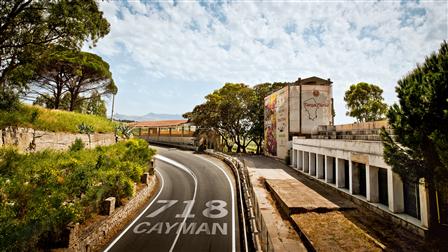
In pursuit of curves.
A road through history: The
This year saw the centennial running of Sicily’s legendary
The inhabitants of Cerda can hardly believe their eyes when ten rumbling and puffing race cars gather on the dusty road running through their Sicilian village on the morning of May 6, 1906. The ambitious and distinguished drivers have been invited to the island by Vincenzo Florio, a Sicilian wine merchant and automobile enthusiast, to showcase their powerful vehicles. At intervals of ten minutes, they roar up the hill and out of the village. The race is a marathon for cars and drivers alike, consisting of three laps of roughly 148 kilometers each. After 9 hours and 32 minutes, Alessandro Cagno is the first to cross the finish line in his impressive Itala race car—and the first to ever win the
And now 110 years have passed since that historic spring morning. The contest itself has taken place one hundred times on different routes—sometimes the endless, breakneck laps of a hilly circuit, sometimes more than 1,000 kilometers around the island. This road race has always been an adventure. It has also been the ultimate challenge for the most determined drivers and the best race cars in the world; its winding segments in the mountains demand agility and lightweight construction, whereas the long stretches along the Mediterranean call for sheer speed. And its winners have made history. Along with Le Mans and the Nürburgring, the
![[+]](https://staging.www.porsche.com/filestore/image/multimedia/none/christophorus-issue377-article06-content-01/normal/551ccf2b-3896-11e6-9225-0019999cd470/porsche-normal.jpg)
The 718
Even today, the mountain roads of Sicily are not for the faint of heart. Anyone who wants to slice curves and shave seconds here needs an iron resolve—and an uncompromisingly aggressive driving machine. A “Little Bastard,” to echo the great
Hill and dale: The
By May of 1959, the
A far happier fate awaits their competitor
![[+]](https://staging.www.porsche.com/filestore/image/multimedia/none/christophorus-issue377-article06-content-02/normal/c2727496-3e14-11e6-8697-0019999cd470/porsche-normal.jpg)
Purism and agility: The 718
A shiver of awe runs down my spine as I bring the Miami Blue 718
With four cylinders instead of the previous six, the new
![[+]](https://staging.www.porsche.com/filestore/image/multimedia/none/christophorus-issue377-article06-content-03/normal/3a1a957e-3897-11e6-9225-0019999cd470/porsche-normal.jpg)
Charming backdrop: Nearly every kilometer of the
Style! The 718
The classic 72-kilometer lap, or “Piccolo Circuito delle Madonie,” that I am following begins in Cerda, running counterclockwise up a 500-meter hill lined with gnarled trees and dense thickets and then down to a valley—only to head right back up onto twisting mountain roads. From there follows the little town of Collesano in the east, which boasts the
How would the new
Umberto Maglioli and Giancarlo Baghetti drove the 718 W-RS Spyder to seventh place overall in 1963.
The classic
In the 1970s, the
By Jan Baedeker
Photos by Stefan Bogner
![[+]](https://staging.www.porsche.com/filestore/image/multimedia/none/christophorus-issue377-article06-margin-01/normal/1b0dad47-3896-11e6-9225-0019999cd470/porsche-normal.jpg)
![[+]](https://staging.www.porsche.com/filestore/image/multimedia/none/christophorus-issue377-article06-margin-02/normal/c5f78ef4-3896-11e6-9225-0019999cd470/porsche-normal.jpg)
![[+]](https://staging.www.porsche.com/filestore/image/multimedia/none/christophorus-issue377-article06-margin-03/normal/798e5726-3897-11e6-9225-0019999cd470/porsche-normal.jpg)
![[+]](https://staging.www.porsche.com/filestore/image/multimedia/none/christophorus-issue377-article06-margin-04/normal/643f4abe-3898-11e6-9225-0019999cd470/porsche-normal.jpg)
![[+]](https://staging.www.porsche.com/filestore/image/multimedia/none/christophorus-issue377-article06-margin-05/normal/6aba6bd8-3898-11e6-9225-0019999cd470/porsche-normal.jpg)









